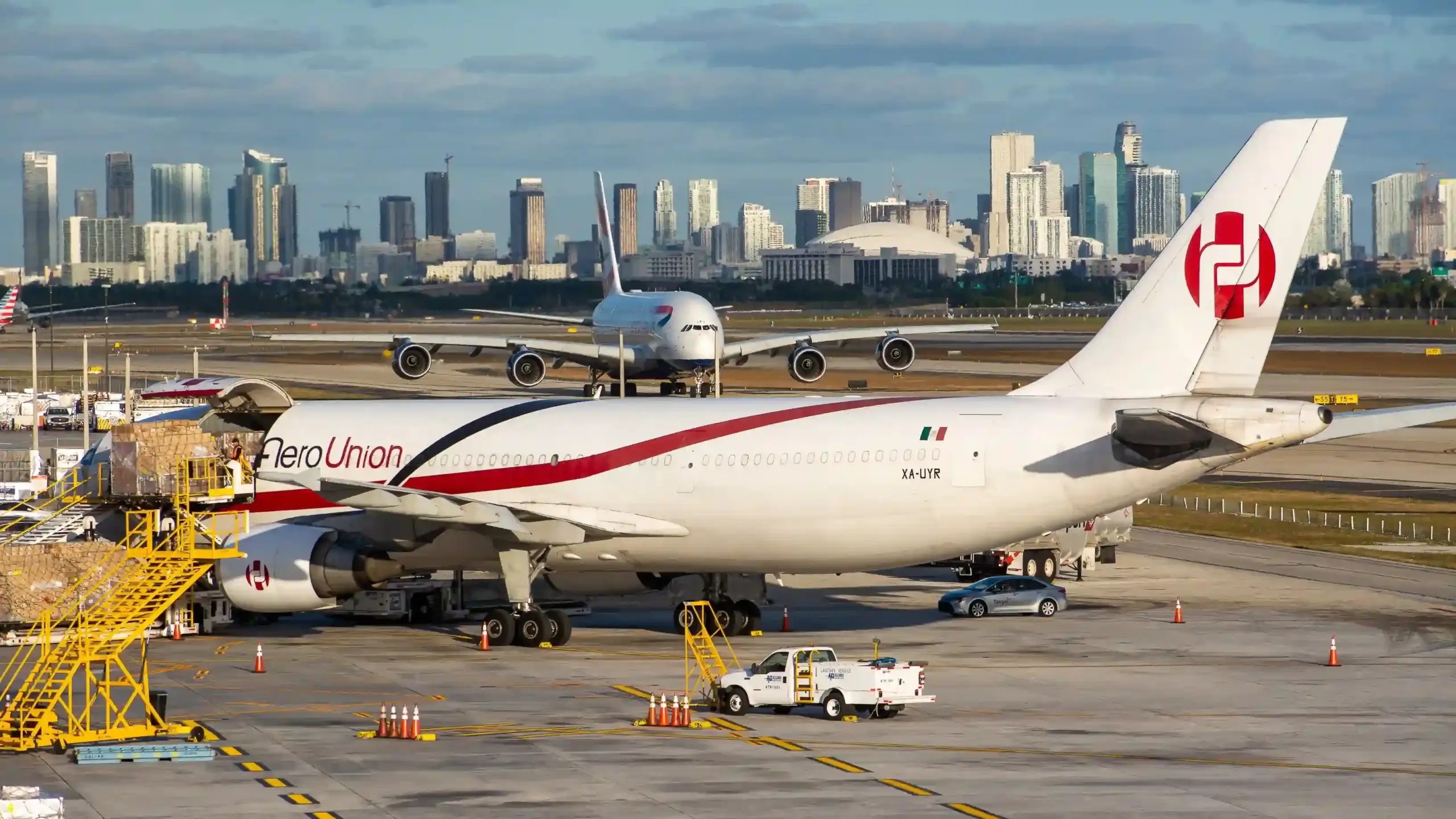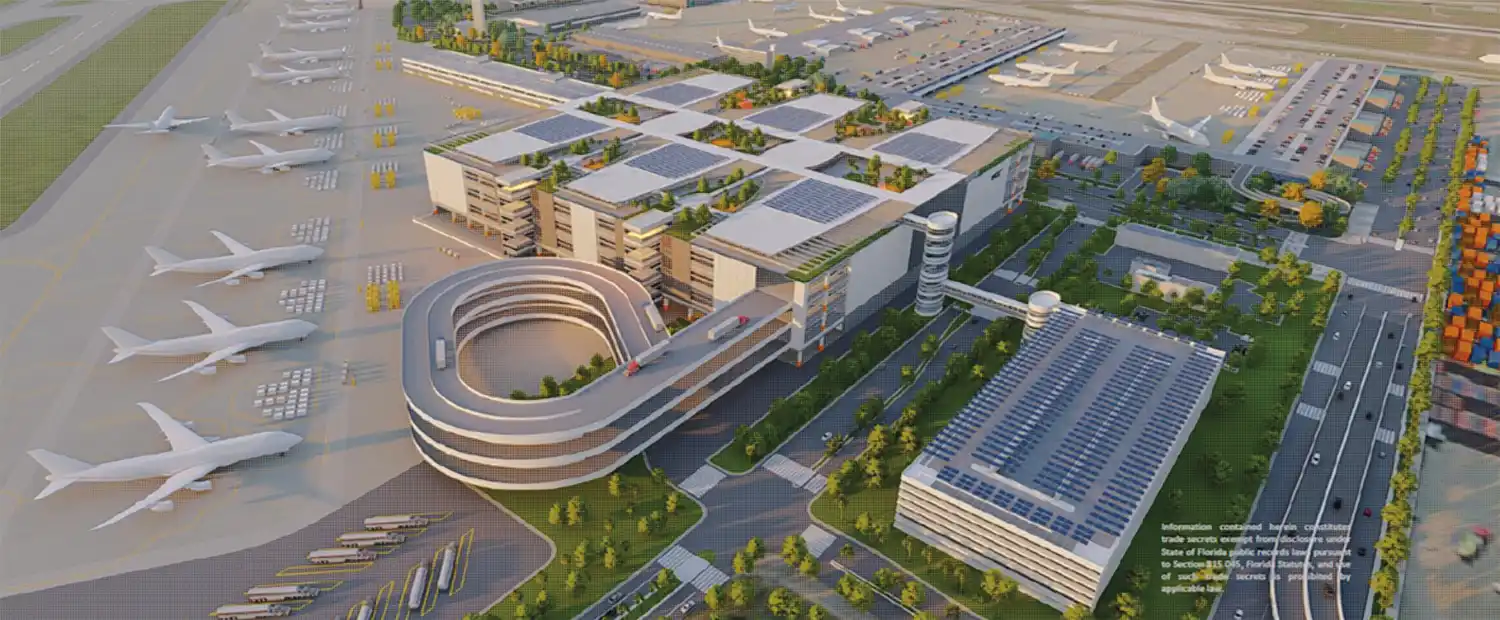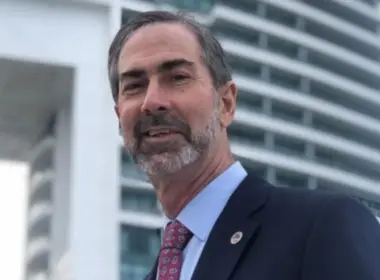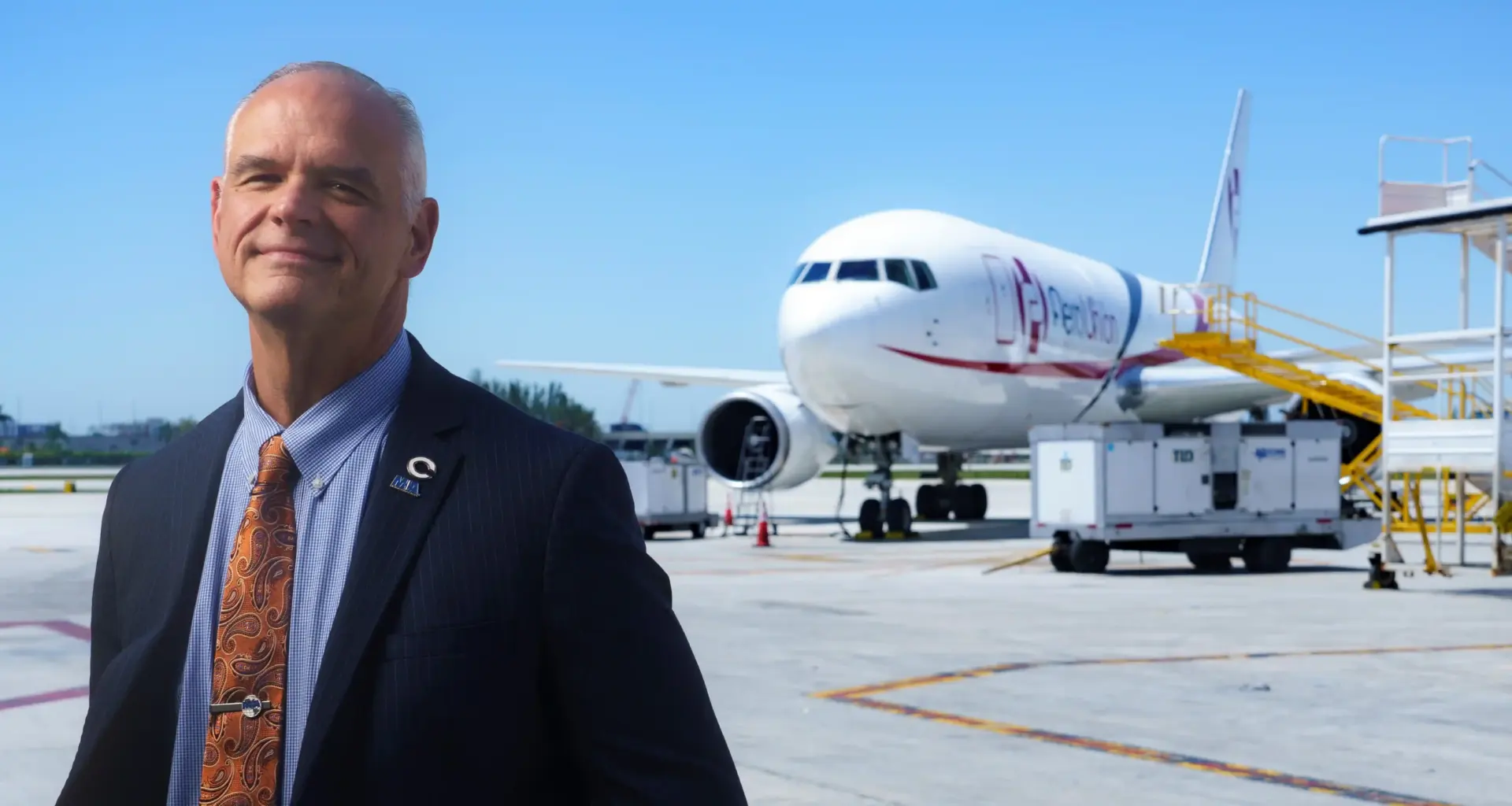Miami International Airport’s High-Flying Expansion
By Kylie Wang
In early February, a group of about 30 people gathered at Miami International Airport (MIA) for a press conference. They were herded through an expedited security line and up a short escalator to a small platform between floors. As passengers headed to and from the Skytrain on the floor above, the entourage assembled to watch Miami-Dade Mayor Daniella Levine Cava and a band of county and airport VIPs announce MIA’s latest success – in 2022, Miami’s airport had surpassed 50 million passengers for the first time in its history.

“Two years after the pandemic devastated the travel industry, your hometown airport is now leading the state of Florida and the United States in multiple travel categories,” Levine Cava announced to a round of applause. She was followed by Ralph Cutié, the airport’s director and CEO, County Commissioner Roberto J. Gonzalez, and J.C. Liscano, the vice president of American Airlines’ Miami hub, among others. The band of observers, members of the press among them, then ate slices of the “50 Million” cake and went home.
It was a relatively small event for a such a large accomplishment. With 50.6 million passengers last year, MIA cemented its position as Florida’s largest economic generator, surpassing Orlando’s airport by half a million passengers for the first time in six years and shattering the previous pre-pandemic record set in 2019 by 10 percent.
“Those 50.6 million passengers represent far more than just another number,” Levine Cava said. “These are millions of guests in our community who are supporting our hotels, our restaurants, our shopping centers, and other businesses – and, most importantly, creating jobs right here in Miami-Dade County.”

Somehow, some way, MIA figured out the formula for post-pandemic success. Much of that credit lies in the hands of Ralph Cutié, who took the reins in 2021 and helped steer the airport out of one of the most challenging periods in its history. MIA came out the other side with an ongoing 15-year, $7 billion-plus capital improvement program that includes over 150 projects, a planned vertically integrated cargo facility (negotiations are ongoing), a VIP terminal (expected in 2026), and 15 new carriers (12 passenger and three cargo) since 2020.
MIA is now the number two airport in the U.S. for international passengers and ranks eighth in total passengers. It’s within the top 25 for both of those categories worldwide. So how did it reach 50.6 million passengers in only a year of post-pandemic recovery? Two words: Low-cost carriers.
A CHANGE IN BUSINESS MODEL
“[During the pandemic], many carriers either stopped operating or reduced their flights considerably, which opened up an enormous opportunity for low-cost carriers,” says MIA’s Director of Marketing and Air Service Development Emir Pineda. Historically, Fort Lauderdale-Hollywood International Airport has been the premier low-cost carrier destination airport in South Florida, but Pineda says MIA’s new business model, implemented right before the pandemic, turned the tide in its favor. “Before COVID, low-cost carriers represented about 2.5 percent [of carriers at MIA],” Pineda says. “Today, they represent between 13 and 15 percent.”

The agent of change was simple: The airport began using preferential gates over common ones. Preferential gates are used exclusively by a single carrier, meaning that large carriers like American Airlines, which runs multiple flights per day, don’t have to move their planes around a full terminal, but can just cruise right up to their established gates. This allows them to turn around flights much quicker – “a great advantage,” according to Pineda.
Low-cost carriers, which often do a lot of turnovers per day, were intrigued. “All of a sudden, we had the interest of Southwest, JetBlue, Spirit, and low-cost carriers in Latin America that looked at Miami as a new destination point,” Pineda says. “We saw a huge growth in the domestic travel market.” Frontier Airlines, another budget airline which had already been in service at MIA, increased their flights as well.

Preferential gates are usually reserved for domestic airlines, since they have the most flights; to be a candidate for one, you have to run five or more per day. It’s a much better business plan than using “slots,” Pineda says, where carriers are given a specific time to get to the airport and missing that time can mean there is no room left for the aircraft.
The system also helps manage capacity issues like how many ticket counters are available at a given time, and what Pineda calls the TSA checkpoint “bottleneck.” The expanded facilities, as well as the software to monitor and expedite the flow of passengers, are part of MIA’s Capital Improvement Program (CIP), which is estimated to be fully completed in 2038, 15 years from now.
IMPROVING & EXPANDING
The CIP is wide-ranging, with some projects bigger than others. Many of the larger ones have multiple phases. But, says Director and CEO Cutié, the three most important are the South Terminal expansion, the extension of the D60 section within the North Terminal, and the redevelopment of the Central Terminal.

The South Terminal expansion, or Concourse K, will add another six international gates, more space for concessions, and larger lounge spaces, the latter of which are in “big demand in the industry right now,” according to Cutié. The new international gates are a necessity considering MIA’s projected growth of 77 million passengers by 2040, a good percentage of which will come from overseas. The South Terminal expansion includes 11 distinct projects, the last of which should be completed by the end of 2029.
The extension of D60 includes expanding both the building and the ramp area of the North Terminal, which is where most regional traffic flies from. “Many of the flights to our national and state capitals of Washington [D.C.] and Tallahassee go out of the D60 area,” Cutié says. “It’s an older section of the terminal. The ceilings are low, and you have to go outside for all the flights.” Currently in D60, there are no “contact gates,” the bridges passengers use to board planes, which means travelers have to board the plane outside via a staircase, exposed to the elements. “The new version of D60, which is currently in conceptual design, would potentially include approximately 17 contact gates,” Cutié says. “It’s [going to be] a much nicer facility; two or three stories, glass-enclosed, really beautiful.”
The third major project in the CIP is the two-phase redevelopment of the Central Terminal which, at 60-plus years, is the oldest in the airport. “I compare it to ‘The Wizard of Oz,’” Cutié says. “You’re Dorothy, and you go back to Kansas, and everything becomes black and white. That’s Central Terminal. If you go from North or South Terminal into Central, you can tell there’s a difference. That’s the part that needs the most tender loving care.” Currently, the project is moving into the design solicitation phase and is expected to cost over $700 million alone.
Other ventures are what Cutié refers to as “enabling projects” that help with the operation of improvements to come. In total, the 150 or so projects of the CIP will cover everything from new gates to upgraded parking facilities to the modernization of bathrooms and more. There will be demolitions, relocations, and construction galore. All of this to manage that magic number of 77 million projected passengers by 2040.
With more passengers comes a need for more amenities as well, which is why the airport is also planning to build two new hotels as part of the CIP. One, a public-private partnership between the airport and a hotel operator, is set to be awarded within the next few months, likely to FDR Miami Hotel LLC. It will include state-of-the-art facilities with 451 rooms, an 18,000-square-foot business and conference center, a four-star restaurant, and a rooftop swimming pool. The other, a slightly more economical option, will be built later in the CIP schedule. In addition, the current hotel on the airport’s property will also be given its own renovations, bringing MIA’s total to three on-site hotels.

At the apex of the airport’s amenity upgrades is a project outside of the Capital Improvement Program: the new VIP suites. Developed by Private Suite, the company which already operates such VIP comforts at LAX, the new service will streamline travel for those willing to pay the $4,850 price tag for membership. “It’s somewhere between regular commercial travel and flying a private jet,” Cutié says. “You show up, they valet park your car, and then you go inside where you’ll be treated like royalty. You’ll have whatever food and drinks you want, you can lay out and relax, take a nap, take a shower, go to the spa. Most importantly, you can clear TSA and Customs there. And if you have checked bags, they’ll get them to the plane. When it comes time for you to go, they’ll drive you in a limousine on the tarmac to the door of your plane. It takes away all the headaches.”
The suites will be in the old Pan Am headquarters building on 36th Street, which Private Suite is going to renovate on its own dime. The project, which will cost the county nothing, is projected to bring in at least $16 million to the airport from rent and revenues over the course of Private Suite’s 20-year lease, and up to $60 million if all goes well. “It’s a cool project because it’s in a building that wasn’t occupied,” says Cutié. “Nobody was there, and we weren’t making any money on it.”
The plans were approved by the airport’s board about a month and a half ago and the project is now in the design phase, expected to break ground within a year. Private Suite is further incentivized to complete construction quickly by a clause in its contract with the airport that penalizes the company if they take longer than three years to finish.
THE CARGO FACTOR
In the midst of all of this are the ongoing negotiations on the Vertically Integrated Cargo Community (VICC), a project that was proposed to the county by a privately held company in 2020. Once those plans are finalized and approved by the Board of County Commissioners, the project can move forward. When completed, MIA will have the United States’ first vertically integrated cargo facility, which will potentially double its cargo capacity and satisfy cargo demand for the next 25 years. MIA is already No. 1 in the U.S. and No. 7 in the world for international freight but is rapidly outgrowing its facilities, despite $70 million-plus expansions from both DHL and FedEx in the last few years.

Cargo has been an important part of MIA’s post-pandemic recovery, in large part due to the airport’s unique ability to handle medicinal perishables. In 2015, MIA was named a “pharma hub” by the International Air Transport Association (IATA), only the second airport in the world to receive the certification due to its extensive “cold-chain” network. “Cargo has always been very valuable, but it really delivered tremendous value during the pandemic,” says Lars Pottgiesser, IATA’s head of business development for the Americas. “First, it was transporting supplies and medical equipment, then medical workers and vaccines. Miami having excellent cargo facilities, that obviously played a key role in its recovery.”

The VICC will propel MIA even further in the international cargo realm. During Cutié’s State of the Ports address in late 2022, when he announced the project, he noted that the airport’s current cargo infrastructure would be approaching its capacity this decade.
Pottgiesser further posits cargo as the reason for most airport recoveries worldwide, adding that “Miami did particularly well,” partly because it has so much connectivity with Latin America. “Latin America was one of the first regions to recover from COVID, so I think that positioned Miami well,” he explains. Also helpful was Miami’s proximity to Mexico, where restrictions on international flights were never imposed during the pandemic.

ONLY A MATTER OF TIME
In comparison to other airports, Pottgiesser says the growth from MIA in recent years is highly impressive, certainly “not to be expected.” Miami is taking full advantage of its geographic location, he says, similar to hubs like Singapore Changi Airport (SIN) or Panama City’s Tocumen International Airport (PTY), which are also positioned, similarly to Miami, in a way that encourages connectivity between regions.
In the U.S., though Atlanta, Dallas, Denver, and Chicago continue to handle more passengers on a yearly basis, Miami’s growth is arguably more impressive due to its lack of space. “You can’t expand runways, you can’t go anywhere, so it needs to be as efficient as possible,” Pottgiesser says. “Other airports’ growth potential is limitless due to their large geographic footprints. But the advantage that MIA has is that, even with traffic today, it takes around 30 or 35 minutes to get there from Downtown Miami. To get from Downtown Atlanta [to the airport], for instance, takes you more than an hour. So, MIA is really making the best out of the landlock it has, which is quite impressive. In the end, both the passenger and MIA win.”
The other advantage Miami has is the sheer number of unique airlines that operate out of MIA. Currently, there are 99 passenger and cargo airlines going through Miami, just one shy of where the airport was pre-pandemic in February 2020. At that time, 100 was the most among all U.S. airports.
If Miami has one obvious weakness it’s the airport’s lack of connectivity to Asia, due to the enormous distance. But, with the advent of new aircraft like the Airbus A319, some airlines are now launching longer flights. Jetblue, which flies nine flights out of MIA every day, can now make it all the way to Paris or Amsterdam without having to stop for a layover in London, for instance. And Japan Airlines is already considering a direct route to Tokyo from MIA. “It’s just a matter of time,” according to Pottgiesser.
Could that sentiment also be applied to MIA overtaking Atlanta as the busiest airport in the world? With each year, it becomes likelier.













